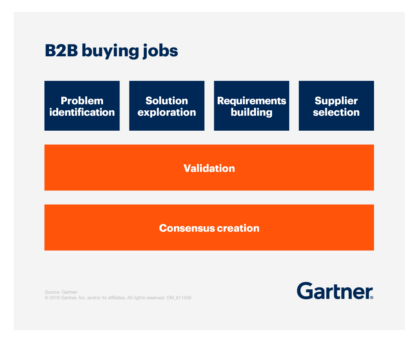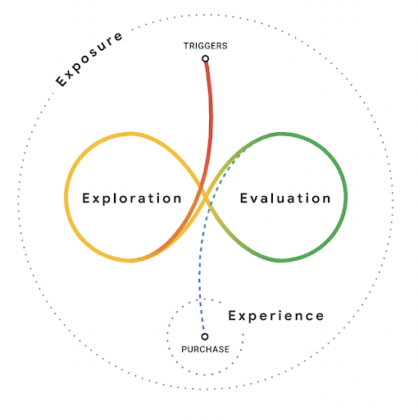When researching the key challenges of B2B marketers, the complexity of the buyer journey always comes top of the list. With decision-making processes increasingly decentralised and influenced by multiple interaction points and stakeholders, gaining more clarity on this journey is crucial for marketers aiming to effectively tailor their strategies and drive those all-important conversions.
From identifying key touchpoints to leveraging data-driven decision-making, today we delve into the methodologies and strategies essential for unravelling the B2B buyer journey. But first let’s take a look at why the B2B buyer journey is deemed so complex and how it differs from B2C.
What makes the B2B buyer journey so complex?
Multiple decision makers
In B2B transactions, decisions often involve multiple stakeholders across different departments. You’re not selling to individuals, you’re selling to teams, often with very different priorities and requirements. This means we must identify and understand each stakeholder’s role, needs, and preferences to tailor the messaging effectively.
Longer sales cycles
In B2B there are typically bigger deal sizes on the table, which translates into slower decision-making. For marketers, this poses an additional challenge in terms of maintaining engagement throughout these extended periods and providing relevant content and support at each stage.
Complex buying processes
B2B buying processes can be intricate, involving various stages such as problem identification, research, evaluation of alternatives, negotiation, and implementation. Marketers must map out these stages and anticipate the informational needs and pain points of buyers at each step. More on this further on in this article.
Information overload
Both B2B and B2C buyers find themselves bombarded with information and content from various sources, making it challenging for marketers to cut through the noise and deliver messages that resonate. Marketers must ensure their content is not only informative but also engaging and tailored to the specific needs and preferences of their target audience.
In a nutshell, there is a lot to consider, particularly when many B2B buyers of complex solutions express a strong preference for a purchase experience free of sales rep interactions.
Understanding the B2B buyer journey
While the traditional marketing funnel model (Awareness, Consideration, Purchase) still applies, as we just saw, the buyer journey is often more complex. This brings the need for a more detailed and granular understanding of the journey to then allow us to map out tactics into each stage.
Before digging into a very helpful framework that can help us better understand B2B customers, it is also useful to remember that 80% of buyers will already have a set of vendors in mind before they even do any research. And, more importantly, an incredible 93% of them will ultimately buy from their Day One list. So while it’s key for marketers to reach out to customers actively seeking for a solution, it’s equally important to keep getting your brand in front of the 95% of customers not yet in active buying mode to make it onto the all-important Day 1 list.
Gartner’s B2B’s buying jobs is an excellent framework to work from in order to get clarity on how customers advance through a complex purchase. The research identifies six B2B buying “jobs” that customers must complete to their satisfaction in order to successfully finalise an actual purchase.

From problem identification to getting everyone on board, all B2B buyers – no matter whether they are in SaaS or manufacturing – will go through a very similar process. The “messy middle”, a model first developed by Google to show how consumers loop between exploring and evaluating the options available to them until they are ready to purchase, is very much at play here:

The B2B buying journey is by no means linear and buyers will often revisit one or more of the jobs above, with some stages happening simultaneously.
Who are the B2B decision makers?
So far in this article we have been talking about “buyers” but, if we truly want to get the full picture, it is important to remember that the buyer – the person or team who will ultimately purchase the solution – is only one of many entities involved in the process. In fact, often different individuals and teams will play more than one role.
Alongside buyers, we have to take into account the needs and preferences of other stakeholders including:
- End users: those who are actually going to use the product/service
- Initiators: those who first spot a problem and voices out the need for a new solution, such as Operations
- Influencers: those within an organisation whose opinion might affect the choice of the decision maker, such as HR or IT
- Decision-makers: those who will ultimately make the final call and approve the purchase and budget, such as Finance or a C-level executive
9 tactics to get insights into the B2B buyer journey
So where do we begin to truly understand what customers want at each stage? Here are some effective methods to understand the behaviour, preferences, and pain points of your target audience:
- Customer interviews and surveys: reach out to your existing customers, prospects, and other stakeholders to gather qualitative and quantitative insights into their purchasing process. Ask about their decision-making criteria, challenges they faced, and factors that influenced their choices.
- Third-party research: research broad themes and trends to understand the context in which your customers are making decisions. You can then use first-party research such as interviews to dig into these themes further.
- CRM data: when set up correctly, your CRM is an extremely valuable source of data on customer interactions and behaviours. Analyse CRM data to identify patterns, trends, and common touch points throughout the buyer journey.
- Analytics: use web analytics tools to monitor visitor behaviour on your website. Track which pages they visit, how much time they spend on each page, and where they drop off in the conversion process. This data can provide valuable insights into the buyer’s interests and preferences.
- Implement marketing automation: marketing automation platforms can help track and analyse customer interactions across various channels, including email, social media, and website. Use automation to segment your audience, deliver targeted content, and track engagement throughout the buyer journey.
- Monitor Social Media engagement: social platforms offer valuable insights into customer conversations, preferences, and sentiment. Monitor the most relevant channels for mentions of your brand, industry trends, and competitor activity to gain a deeper understanding of your target audience.
- Collect feedback from Sales teams: your sales teams interact directly with prospects and customers on a daily basis and have access to huge amounts of valuable information. Collect their feedback to understand common objections, frequently asked questions, and areas where prospects may need additional information or support.
- Audit your competitor activity: analyse their tactics, messaging, and customer interactions. By understanding how competitors engage with their audience, you can identify gaps in your own approach and differentiate your offerings effectively.
- Attend industry events and conferences: Participate in industry events, conferences, and networking opportunities to connect with potential buyers and gain firsthand insights into their challenges and priorities. Engage in conversations, attend workshops, and gather feedback to inform your marketing strategies.
The B2B buying process has changed – your sales and marketing strategy must, too
To succeed in the current B2B environment, delivering generic, product-based messaging isn’t going to cut it. Nor is focusing on the buyer while neglecting the other stakeholders involved in the decision-making process. Enhancing your sales effectiveness requires dedicating time to building out a seamless process which has to start with a successful alignment between sales and marketing.
While having an excellent understanding of your product or service is crucial, it’s even more critical to discern where your buyers and other entities stand in their journey and develop strategies to help them move forward to the subsequent stage.
Can we help you?
Having a clear understanding of your customers’ behaviours and needs is the catalyst for more effective decision making. Want to discuss how to get further visibility into your buyer journey and how it can help your brand grow? Reach out to our strategy team.






